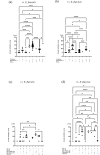Comprehensive analysis of bacteriocins produced by clinical enterococcal isolates and their antibacterial activity against Enterococci including VRE
- PMID: 39924578
- PMCID: PMC11808071
- DOI: 10.1038/s41598-025-89518-8
Comprehensive analysis of bacteriocins produced by clinical enterococcal isolates and their antibacterial activity against Enterococci including VRE
Abstract
It is well-known that Enterococcus species produce bacteriocins that have antibacterial activity. However, a comprehensive analysis of the bacteriocin distribution among Enterococcus strains has not been conducted. In this study, we identified the bacteriocin genes from 80 Enterococcus faecalis and 38 Enterococcus faecium strains and investigated their antibacterial activity. In the 80 E. faecalis strains, the cytolysin gene (61.3%), enterolysin A gene (27.5%) and BacL1 gene (45.0%) were identified. In the 38 E. faecium strains, the enterocin A gene (97.4%), enterocin B gene (2.6%), enterocin NKR-5-3B gene (21.0%), bacteriocin T8 gene (36.8%) and BacAS9 gene (23.7%) were identified. The antibacterial activity of all strains was tested against E. faecalis and E. faecium. The strains positive for the cytolysin, enterolysin A, BacL1, bacteriocin T8 or BacAS9 genes presented variable antibacterial activity. Several bacteriocin-positive strains showed antibacterial activity against other enterococcal species, but not against Staphylococcus or Escherichia coli. In addition, the enterolysin A-positive strain showed antibacterial activity against vancomycin-resistant E. faecium, and the bacteriocin T8- or BacAS9-positive strains showed activity against vancomycin-resistant E. faecalis and E. faecium. Our findings suggest that E. faecium and E. faecalis strains that carry different bacteriocin genes may affect the composition of the surrounding bacterial community.
© 2025. The Author(s).
Conflict of interest statement
Declarations. Competing interests: The authors declare no competing interests.
Figures







References
-
- Neelakanta, A. et al. Impact of changes in the NHSN catheter-associated urinary tract infection (CAUTI) surveillance criteria on the frequency and epidemiology of CAUTI in intensive care units (ICUs). Infect. Control Hosp. Epidemiol.36(3), 346–349. 10.1017/ice.2014.67 (2015). - PubMed
-
- Fernández-Guerrero, M. L. et al. Nosocomial enterococcal endocarditis: A serious hazard for hospitalized patients with enterococcal bacteraemia. J. Intern. Med.252(6), 510–515. 10.1046/j.1365-2796.2002.01061.x (2002). - PubMed
MeSH terms
Substances
LinkOut - more resources
Full Text Sources
Medical

